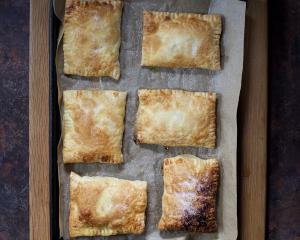Once you have tasted a good balsamic vinegar, dark glossy brown, intense, sweet, tart and fragrant, your pantry will never be without it.
A quick look at the shelves in supermarkets and upmarket food stores shows a bewildering array of balsamic vinegars with widely differing prices. How do you choose?
There is not just one balsamic vinegar, there are several types, and understanding the differences is somewhat complex.
There are three basic categories: traditional, condimento, and aceto balsamic vinegar of Modena I.G.P., plus a raft of derivative products such as balsamic glaze, balsamic syrup and balsamic creams, some sold in squeezy bottles like ketchup.
Traditional balsamic vinegar
Traditional balsamic vinegar is the Rolls Royce of vinegars. At upwards of $180 for a 100ml bottle, it has the complex flavour of a mature wine and can be sipped as an aperitif.
Unlike other vinegars, traditional balsamic is made not from wine but from the must (juice) of white grapes and is reduced by slow simmering to about 30% of its volume. The caramel flavours that are characteristic of this vinegar develop during the reduction process.
The resulting syrup undergoes decades-long fermentation and a slow ageing process that takes it from one wooden barrel to a smaller wooden barrel, each made of different wood. Making the real thing takes at least 12 years.
All this takes place in the attics of the homes in Modena and the surrounding area of Reggio Emilia in northern Italy, Each bottle is labelled Aceto Balsamico Tradizionale, an indication that it belongs to a consortium of producers. It will also have a DOP (Protected Origins) stamp on the label, a European Union certification that guarantees its quality, production and place of origin.
Uses
With its perfect balance of sweetness and acidity, it is best with strongly flavoured food. A few drops perfectly complements an aged cheese, maybe Parmigiano-Reggio, and a scant drizzle over perfectly ripe strawberries is another classic combination. Because of its high cost, this is not the balsamic vinegar to use for cooking or in salad dressings; heating will kill its rich, complex sweetness.
Condimento balsamico
This is a category of balsamic vinegar that is made in the traditional way but for various reasons is not labelled traditional: either it is produced outside the designated region of Modena and Reggio Emilia, or it is not produced under appropriate supervision, or it is made by traditional producers but has not been aged for the stipulated 12 years, so no consortium approval is possible.
Such vinegars, unable to be called traditional despite very similar production methods, are labelled condimento balsamic vinegar. The quality is usually very good and it is likely to be quite a bit cheaper than the traditional balsamics.
Condimento may carry the seal of Consorzio di Balsamico, a body set up to monitor condimento-grade balsamics and a good indicator of quality. However, the name condimento is not a protected designation and can be found on low-grade vinegars as well.
There are some vinegars with the label Consorzio Aceto Balsamico on supermarket shelves. These are not condimento balsamico. They are aceto balsamico de Modena, an inexpensive balsamic vinegar. Condimento should also carry the I. G. P stamp, a guarantee that the product is made in Modena. (More on this later).
Uses
Condimento, although lacking the complexity of traditional balsamic, should offer a pleasing mix of sweetness and acidity and needs to be used very simply. At its best with salty, rich ingredients such as plainly cooked salmon, pork belly, scallops, prawns and shrimps, it acts as a natural flavour enhancer. Good too drizzled over simple pastas or risottos.
Sprinkle a little over sliced ripe pears, pannacotta or creme caramel and the effect is amazing.
I don't think condimento works so well with bland food.
Drizzle a few drops over an aged cheddar and it is perfect but do the same with mozzarella and the effect is wasted, as it is with very elaborate dishes - too many flavours competing.
Aceto balsamic of Modena I. G. P.
During the 1970s, balsamic vinegar became very fashionable all over the world. Because the traditional production in and around Modena was so small, people began manufacturing it commercially to meet the demand.
These balsamic vinegars of Modena I. G. P. are the ones you will find on the supermarket shelves, but buyer beware, because it is a bit of a minefield.
- Joan Bishop
Balsamic and orange chocolate cakes
Makes 36
These gorgeously aromatic small cakes, intensely chocolatey, sweet but smoothly sharp are quite irresistible. They are easy to make and I regard them as a pantry standby. You are likely to have all the ingredients in the kitchen. No need for a mad dash to the supermarket.
I much prefer small cakes; I do love a little sweet something with my espresso. However, this mixture works just as well in a larger muffin tin so feel free to choose.
I think the balsamic vinegar is an inspired flavouring, accentuating the sweetness and deep mellow flavour of these dark moist little cakes. The one I use is a Mazzetti brand, balsamic vinegar of Modena I. G. P. (the label pictures a black leaf on a red band), about $6 from most supermarkets. There are a number of really cheap vinegars labelled balsamic but many of them are harsh vinegars sweetened with a little sugar and caramel. Don't use these.
Ingredients
50g cocoa powder
200g standard flour
½ tsp baking soda
½ tsp baking powder
¾ tsp ground cinnamon
2 large eggs, size 7
250ml plain unsweetened yoghurt
100ml neutral-flavoured oil, like rice bran
180g dark cane sugar or muscovado sugar
zest of 1 orange
2 Tbsp orange juice
¼ cup balsamic vinegar
Icing
170g icing sugar
3 Tbsp cocoa powder
2 Tbsp cream cheese (I use Philadelphia extra light)
1 Tbsp boiling water
Method
Preheat the oven to 170degC bake or 150degC fan bake.
Lightly oil 36 mini-size muffin tins (20ml) or 18 standard-size tins (quarter cup).
Sift the cocoa powder, flour, baking soda, baking powder and cinnamon in a bowl and set aside.
Place the eggs, yoghurt, oil, sugar, orange zest, juice and balsamic vinegar into the bowl of a food processor and process until the mixture is smooth, about 10 seconds. Scrape down the sides of the bowl and process again briefly.
Add all the dry ingredients and very briefly pulse 3 or 4 times until barely combined. To make without a food processor: Beat together the eggs. yoghurt, oil, sugar, orange zest, juice and balsamic vinegar until thick and creamy. Sift the dry ingredients together and fold into the wet ingredients until barely combined.
Spoon the mixture into the prepared muffin tins, filling the little ones almost to the top and the larger ones two-thirds full.
Bake for 15 to 18 minutes in the preheated oven until the cakes are springy to the touch. The larger cakes will take a few minutes longer.
Remove from the oven and cool in the pans for about 5 minutes before turning out on to a wire rack to cool.
To make the icing, sift the icing sugar and cocoa powder into a bowl. Add the cream cheese and boiling water and mix until smooth.
When the little cakes are completely cold, ice with the chocolate icing.
What to choose?
Look for the label Aceto Balsamico di Modena I. G. P. The letters stand for Protected Geographical Indication. Since 2009, the label has been a guarantee from the European Union that the vinegar is produced and matured in Modena, under specific regulations. Although nowhere as rigorous as the criteria for traditional balsamics, it does ensure a certain controlled standard of quality.
The letters I. G. P. appear on the label along with the yellow and blue I. G. P emblem showing two furrowed hillsides surrounded by a ring of stars.
Made from a combination of grape juice (must) and wine vinegar, the grapes need to be processed in Modena, although they can come from anywhere in the world. Cooked in vats and aged for a minimum of two months, the vinegar may contain thickening agents and caramel. If labelled Invecchiato (aged), it has been aged in wooden barrels for more than three years.
When choosing a balsamic vinegar of Modena I. G. P., go straight to the ingredients list.
The first item to be listed should be grape must (juice), followed by wine vinegar. However, the majority of the I. G. P. balsamics have wine vinegar listed first, followed by grape must.
Those with grape juice as the major ingredient are quite a bit sweeter, with greater depth of flavour, and they are also more expensive.
There are two that I like.
Elsa Aceto Balsamico di Modena I. G. P., available from Marbecks at $43 for 250ml, is not cheap and I may not be able to justify keeping it as a pantry staple, but it is the one I like best.
Mazzetti Aceto Balsamico di Modena I. G. P. has been aged for three years in wooden barrels (it has a manufacturer's grading of four gold leaves on a black background). It is on some supermarket shelves and is about $12 for 250ml.
Uses
These sweeter, pricier I. G. P. balsamics can be used as you would a condimento, although they lack some of the condimentos' syrupy thickness and complexity of flavour.
Those I. G. P. balsamics listing wine vinegar as their first ingredient are more acidic. They resemble regular vinegar without its harshness and with a hint of sweetness. Two I have tried and liked, both Mazzetti Aceto Balsamico di Modena I. G. P. One has the manufacturer's grading of three black leaves on a gold background and is available at some supermarkets for about $10.00 for 250ml. The other has one black leaf on a red background and is about $6.00 for 250ml.
These give a good flavour boost to soups and casseroles and work wonders in dips and marinades. Quite tart, they are good in salad dressings and vinaigrettes. These are the ones I use when baking.
I have been visiting supermarkets and gourmet food stores all over town (I could have missed one) but I have not been able to find tradizionale balsamic vinegar (at upwards of $180 for 100ml, that is hardly surprising). Nor have I found condimento balsamic vinegar.
A note on white balsamic vinegar: As this is slow cooked so that caramelisation does not occur, it is not a true balsamic vinegar. It is quite simply a sweet white wine vinegar.












